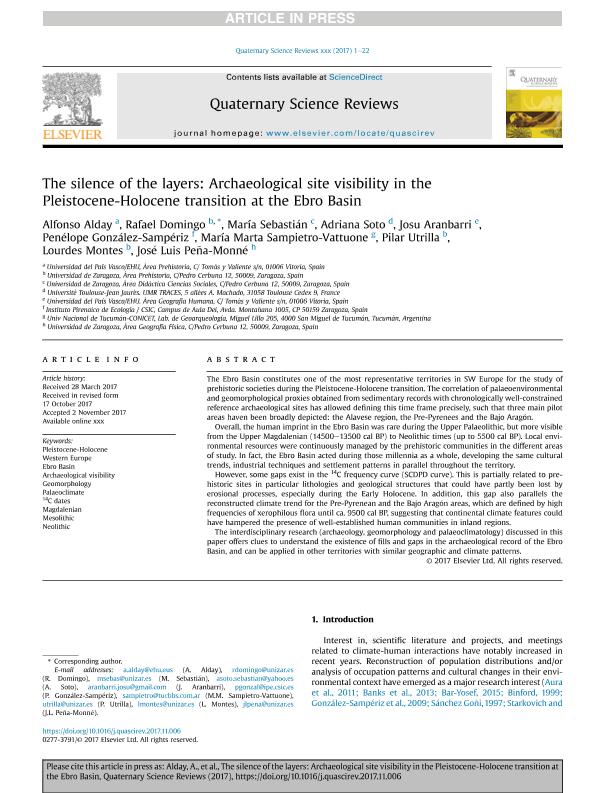Artículo
The silence of the layers: Archaeological site visibility in the Pleistocene-Holocene transition at the Ebro Basin
Alday, Alfonso; Domingo, Rafael; Sebastián, María; Soto, Adriana; Aranbarri, Josu; González Sampériz, Penélope; Sampietro Vattuone, Maria Marta ; Utrilla, Pilar; Montes, Lourdes; Peña Monné, José Luis
; Utrilla, Pilar; Montes, Lourdes; Peña Monné, José Luis
 ; Utrilla, Pilar; Montes, Lourdes; Peña Monné, José Luis
; Utrilla, Pilar; Montes, Lourdes; Peña Monné, José Luis
Fecha de publicación:
03/2018
Editorial:
Pergamon-Elsevier Science Ltd
Revista:
Quaternary Science Reviews
ISSN:
0277-3791
Idioma:
Inglés
Tipo de recurso:
Artículo publicado
Clasificación temática:
Resumen
The Ebro Basin constitutes one of the most representative territories in SW Europe for the study of prehistoric societies during the Pleistocene-Holocene transition. The correlation of palaeoenvironmental and geomorphological proxies obtained from sedimentary records with chronologically well-constrained reference archaeological sites has allowed defining this time frame precisely, such that three main pilot areas haven been broadly depicted: the Alavese region, the Pre-Pyrenees and the Bajo Aragón. Overall, the human imprint in the Ebro Basin was rare during the Upper Palaeolithic, but more visible from the Upper Magdalenian (14500–13500 cal BP) to Neolithic times (up to 5500 cal BP). Local environmental resources were continuously managed by the prehistoric communities in the different areas of study. In fact, the Ebro Basin acted during those millennia as a whole, developing the same cultural trends, industrial techniques and settlement patterns in parallel throughout the territory. However, some gaps exist in the 14C frequency curve (SCDPD curve). This is partially related to prehistoric sites in particular lithologies and geological structures that could have partly been lost by erosional processes, especially during the Early Holocene. In addition, this gap also parallels the reconstructed climate trend for the Pre-Pyrenean and the Bajo Aragón areas, which are defined by high frequencies of xerophilous flora until ca. 9500 cal BP, suggesting that continental climate features could have hampered the presence of well-established human communities in inland regions. The interdisciplinary research (archaeology, geomorphology and palaeoclimatology) discussed in this paper offers clues to understand the existence of fills and gaps in the archaeological record of the Ebro Basin, and can be applied in other territories with similar geographic and climate patterns.
Archivos asociados
Licencia
Identificadores
Colecciones
Articulos(CCT - NOA SUR)
Articulos de CTRO.CIENTIFICO TECNOL.CONICET - NOA SUR
Articulos de CTRO.CIENTIFICO TECNOL.CONICET - NOA SUR
Citación
Alday, Alfonso; Domingo, Rafael; Sebastián, María; Soto, Adriana; Aranbarri, Josu; et al.; The silence of the layers: Archaeological site visibility in the Pleistocene-Holocene transition at the Ebro Basin; Pergamon-Elsevier Science Ltd; Quaternary Science Reviews; 184; 3-2018; 85-106
Compartir
Altmétricas



